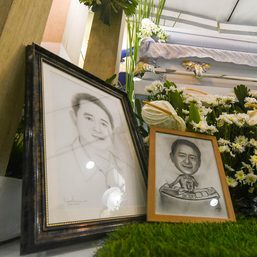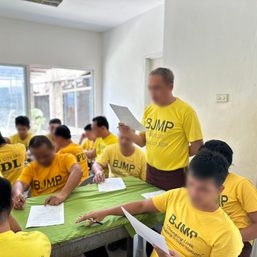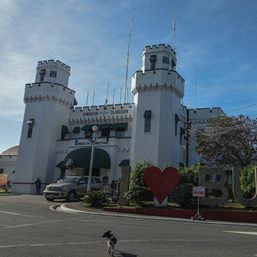SUMMARY
This is AI generated summarization, which may have errors. For context, always refer to the full article.

MANILA, Philippines – A social enterprise called Laya Digital Curators has been working to empower inmates through art to prevent the cycle of poverty-driven crime, while showcasing their artistry through non-fungible tokens (NFTs) and blockchain technology.
The organization provides art training programs in jails, fosters creative expression, and offers opportunities for sustainable artistry, allowing incarcerated artists to reach a global audience and sell their artwork as NFTs.
NFTs represent ownership of unique digital items and have gained popularity in the art world. A type of digital asset, an NFT utilizes the blockchain technology to establish authenticity and ownership.
“We have a vision of helping persons deprived of liberty (PDLs) students find a way of becoming sustainable and preventing the cycle of crime being committed due to poverty through art,” said Ro Javier, the chief executive officer and president of Laya.
Exploring creativity
Based on her previous work at the Lapu-Lapu City Jail with Virtualahan, a non-profit group that provides digital job skills training programs, officers asked Javier to conduct a similar training program at the Manila City Jail.
Instead of simply providing digital skills, she thought of adding an artistic expression component.
Although there are many different training programs offered at the jail, Laya is the only art-based group.
In September 2022, they launched the Laya Art Sustainability Program with 22 PDLs, pre-screened by jail officers.
Javier credits creative director John Paul Mondok for designing the curriculum that first introduces PDL students to theory, then helps them gain confidence in drawing with graphite before graduating to paint.
Initially, there was very little funding for the program. Javier recalled that Mexican artist Jerónimo López Ramírez, more known as “Dr. Lakra,” became their first benefactor because he wanted to work with inmates.
Ramirez donated various art supplies for the students to use. Subsequently, more people sent donations to keep the supplies from running dry.
The challenge was that, due to the nature of their setting, the students could only practice their art during their training sessions, and materials like paintbrushes all had to be collected at the end of each day. Each session was held for five hours, twice a week.
For some classes, volunteer artists would discuss certain topics and their own experiences. The students found it most inspiring when former inmates who became artists addressed the group.
“They found someone to emulate because they had something in common,” Javier said.
Notoriously overcrowded, during their training sessions, the students found a break from the very rigid jail structure.
Javier incorporated inner dance, which involves activating the circadian rhythm with a carefully curated playlist, to facilitate the inmates’ creative expression.
One of the students, Jun (last name withheld), benefited from the program, although he only participated for two months before his release in October 2022.
“Nalibang ako, sa panahong iyon. ‘Di ko naisip na nakakulong ako (I found some diversion during the training sessions. I didn’t think about being in jail),” he said.
In February 2023, 18 inmates from the male dorm graduated from the initial program, since some had been released and a few transferred. The second phase of their training began in May.
Freedom in blockchain
One collaborator is music producer Robert Javier, who, after looking at photographs of each artwork, composes original music. This serves to enhance appreciation for them as non-fungible tokens.
Javier said she sees the blockchain as an equalizing tool.
It’s challenging for the artists who are inside the jail to sell their art the traditional way. The non-fungible tokens give them freedom because it brings their art to the attention of a global audience when they are uploaded on blockchains like Solana or Ethereum.
Laya offers a two-year training program for student artists, focusing on skill development. Once they have mastered their craft, they proceed to learn how to create and sell non-fungible tokens, and enabling them to establish sustainable art careers by showcasing and selling their artwork on digital platforms
Beyond that, the training sessions build more than their skills but also their emotional resilience.
Sustainable artistry
At least five students have successfully sold their artworks to private collectors.
Laya’s artist-in-residence Richard Tercio, a construction worker, sold his mixed media piece titled “Asoge,” created using found materials, at Project Hulmahan’s Hope Lasts live auction.
Eleven of Laya’s students have artwork on projecthulmahan.com. Jun contributed two works: “Walking Trip” and “Glow in the Dark,” using acrylic paint on old shoe lasts.
After seeing his pieces displayed alongside other artists’ works, Jun said he felt a deep sense of fulfillment and was inspired to produce even more.
He said he wants to continue to pursue art but acknowledges the prohibitive cost of materials. So in the meantime, he earns a living as a tattoo artist during Laya-sponsored events.
“Tiyaga lang! ‘Pag may kaalaman ka na, maiisipan mo nang makaalis sa lugar ng mga tukso. (You just need to persevere! When you gain some knowledge, you will want to move away from temptation),” Jun said.
In the meantime, the people behind Laya said they envision a change of mindset where jails become a source of peace and change, and that former inmates will find that they are still welcome in society, and that they will be supported and not stigmatized. – Rappler.com
Mari-An Santos is an Aries Rufo Journalism fellow.
Add a comment
How does this make you feel?




![[Rappler Investigates] The guns of Apollo Quiboloy](https://www.rappler.com/tachyon/2024/04/quibs-guns-carousel.jpg?resize=257%2C257&crop=412px%2C0px%2C1280px%2C1280px)
![[WATCH] Silent Tragedy: Epekto ng war on drugs sa mga bilangguan](https://www.rappler.com/tachyon/2024/06/silent-tragedy-tcard.jpg?resize=257%2C257&crop_strategy=attention)


There are no comments yet. Add your comment to start the conversation.